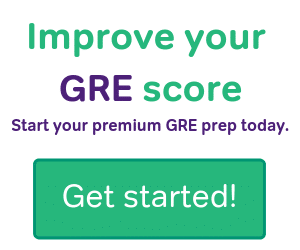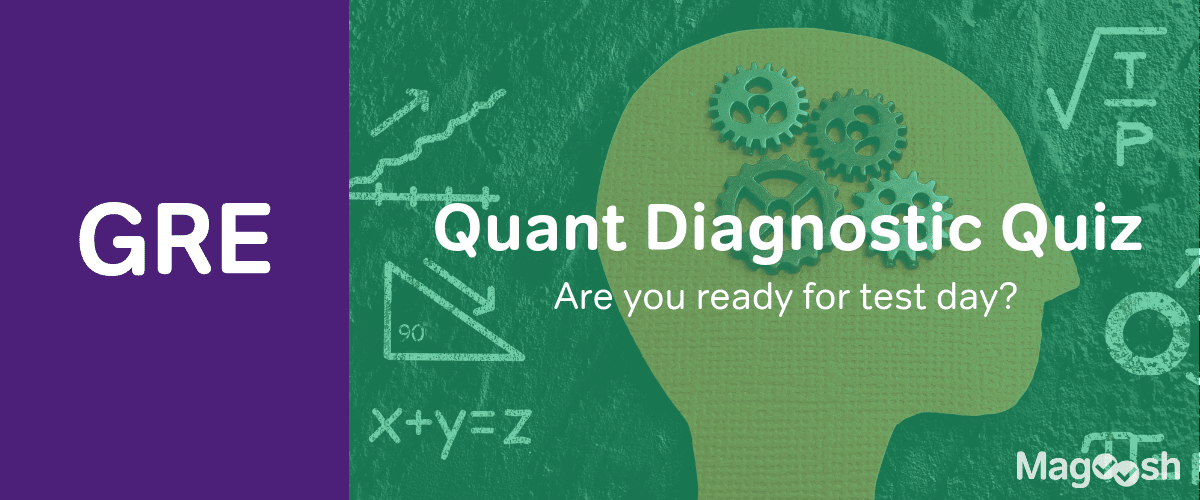
Want to boost your GRE Verbal score? Then work on your GRE Reading Comprehension skills! GRE Reading Comprehension is the most significant part of GRE Verbal Reasoning. In fact, there are 5-7 RC passages and 10-13 of these GRE Verbal question types in each of the two Verbal sections on the exam—meaning that RC questions will always take up roughly half of all Verbal questions on the exam.
However, improving your Reading Comp score requires some reading comprehension practice on your part. After all, the passages themselves can take up some significant reading time. Anywhere from 1-5 paragraphs in length, GRE RC passages are followed by 1-4 questions. When they’re this varied, how can you come up with a GRE Reading Comprehension strategy that will work for everything you’ll see on test day?
Never fear! Magoosh’s experts have put together a guide to everything you need to know about GRE Verbal Reading Comprehension so you can polish your skills and boost your score. Enjoy!
Table of Contents
- Reading Comprehension Introduction
- GRE Reading Comprehension Strategies for Passages
- Approaching the Questions
- The Many Reading Comprehension Question Types
- General Reading Comprehension: The 4 Most Common Question Types
- Factual Detail Questions
- GRE Paragraph Arguments (Critical Reasoning): The 6 Most Common Question Types
- GRE Reading Comprehension Tips for Paragraph Argument Questions
GRE Reading Comprehension Introduction
First of all, know this: Reading Comprehension challenges many test-takers. Part of this is because there are key GRE Reading Comprehension tips and strategies to follow, but no shortcuts to getting an astronomical score. The good news? If you put in the time, you can do it!
One quick caveat: some test-takers believe that because they can read a newspaper, the Reading Comprehension passages and questions will be easy for them. But casual reading is not critical reading.
What’s the difference? Well, as you’ll see right away, GRE Reading Comprehension content can be unfamiliar, the questions can be confusing, and the pacing requirements are stringent. For these reasons, Reading Comprehension is likely to be the most time challenging of the GRE verbal question types. Efficiency is critical to performing well on this section. But you can develop into an efficient test-taker with practice!
Efficiency = Speed + Accuracy
GRE Reading Comprehension Strategies for Passages
For the shorter paragraph argument questions, the reading is fairly straightforward: just read the paragraph from beginning or end, pay close attention to every word, and be prepared to do a careful reread after you look at the question.
For longer passages, approaches to reading need to be more cautious and strategic. Obviously you want to pace your reading properly so you can finish RC in a reasonable amount of time. But RC success isn’t a mere matter of reading quickly. In fact, there’s no point in being fast if you’re not getting the questions right. And nailing the first few Reading Comp questions but then running out of time for the rest of the section won’t do much for your overall score.
So you need a strategy that lets you work quickly and accurately. And we have developed such a GRE Reading Comprehension strategy for you!
Because the passages constructed by ETS (GRE test maker) are fairly consistent and the questions that follow are somewhat predictable we can employ a strategy or methodology suited to meet these expectations.
Four methods of reading and information processing include skimming, scanning, speed-reading, and critical reading.
Method 1: Skimming
Skimming is a reading technique used here to quickly identify the main ideas and thoughts of a passage while under time constraints, especially if it’s subject matter with which you are unfamiliar.
Our “skimming” is a pretty straightforward technique, and different than other kinds of skimming done for other, less-focused purposes.
Skimming is a form of speed-reading that involves scanning (looking quickly but not thoroughly) sentences and paragraphs for clues to understanding, mainly used to get an overall feel for the context.
In skimming you should:
- Contemplate:
- The meaning or purpose of the passage
- The information provided in the passage
- Ascertain:
- The central theme(s)
- The main idea(s)
- Separate:
- The main ideas from supporting ideas
- Test:
- The relevance and strength of the supporting ideas
When skimming, you should ask yourself:
- What’s an appropriate title for this passage?
- How can I summarize this excerpt?
- Where might this passage have appeared — a newspaper, scientific journal?
- For what reason was this piece written?
Method 2: Read the Passage
As you read, make some notes (using scratch paper or other material provided by your friendly test proctor) on:
- main ideas (used in answering main idea questions)
- key points and information (used in answering hunt and peck and inference questions)
- transitions (used in answering inference and style/tone/organization questions)
Method 3: Sum up the Piece and Pinpoint Information
Try to summarize the passage and track the details as you move through the material. These techniques works especially well if you tend to lose concentration as you read.
Remember, this part of the GRE is basically an open-book test, so you don’t need to write down or remember every detail and key point. You just need to know where to find them.
Some passages may have line numbers for references. Some passages may not. In those that don’t, the question stems may reference information in the passage by paragraph number so be conscious of the paragraph breaks as you read.
Method 4: Critical Reading
To be a critical reader you must think critically. A GRE critical reader:
- reads with a purpose – and the purpose is to answer the questions correctly
- recognizes each paragraph as an integrated whole
- understands how each paragraph fits into the overall passage
- evaluates arguments and supporting evidence
Approaching the Questions
Read and Rephrase the Question Stem
The question stem is the part before the answer choices. By identifying the question-type, you’ll know better how to approach the answer choices. Here, the stem reflects the nature of the question leading you to the first paragraph and providing information to answer the: where, when, who, and what questions.
What often happens is you will read the question, and then go back to the passage without understanding what the question was asking in the first place. At this point, you are likely to grasp at words in the passages that look important and look for those words in the answer choices. Instead of falling into this trap, it is best to rephrase the question in your own words. The more straightforward your interpretation of the question, the better you will be able to navigate through the passage when looking for the answer.
Don’t time yourself on the Koko and Chocolate passages. Focus on finding the correct answers. You can work on timing later, with the sample passage and questions.
Review Each Answer Option
Review each answer option critically to eliminate those not supported by the passage. Focus on important words and try to articulate reasons to discard each choice. (Note the answer choices that “contradict” the passage or choices that are “not mentioned” or “not supported” in the passage are favorite GRE distractors.)
Once you think you’ve found the answer, try to phrase the answer in your own words. If you immediately begin scanning the answer choices, you’ll likely get trapped.
Respond to the Question Stem
Make sure your choice responds to the question stem. Refer to your notes and don’t pick an answer until you’ve found the evidence to support it (or lack of evidence to discard it).
When the test writers are creating a multiple-choice question, they create wrong answer choices that fall into several categories. Knowing these categories can help you correctly identify and eliminate wrong answers.
- Too extreme
- Assumes too much
- Beyond the scope of the passage
- Too broad/Too specific
- True…but doesn’t answer the question
Once you’ve eliminated as many answers as you can (ideally, four), pick the best remaining choice and move on.
The Many Reading Comprehension Question Types
There are 11 common question types for GRE RC. This sounds like a lot, but don’t worry– it’s easier to remember them all than you might think. Helpfully, the questions are divided into two groups: question types for Paragraph Argument passages (sometimes still referred to as “Critical Reasoning,” their name on the old GRE), and question types for passages that are not paragraph arguments.
Non-PA Reading Comprehension questions can vary in length. They can even be as short as a single paragraph. But whether a regular RC passage is a paragraph long or several paragraphs long, their questions are distinctly different from those of paragraph arguments. We’ll look at the question types for these more general, non PA passages first.
The Four Most Common Question Types for Short, Medium, and Long GRE Reading Comprehension passages
Here is a list of the four most common question types for regular, non-Paragraph-Argument GRE passages. Click each item on the list for a full, in-depth article devoted to the question type. Or for a “quick hit,” see a brief description of each question type right below the list.
Main Idea Question Type
Main idea questions are exactly what they sound like. You will be asked to identify the main idea, dominant theme, or primary purpose of the passage as a whole. Ways to identify main idea questions and strategies for approaching these questions can be found in Magoosh’s main idea GRE Reading Comprehension tutorial.
Inference Question Type
This is perhaps the most common type of GRE question. As you’d expect, this question type requires test-takers to make inferences based on what they’ve read. What you might not expect is just how strict the rules are for identifying the correct inference.
On the GRE, inferences must be based only on the passage. You shouldn’t infer something to be true based on any personal knowledge of the topic; look only at what’s in the passage. Also avoid inferences that depend on possibilities rather than certainties from the passage. If you find yourself thinking “this inference is true if…”, you are not making a proper GRE RC inference. GRE inferences are only correct because of something concretely stated in the passage, no “ifs” about it.
If this still sounds a little confusing to you, don’t worry. Magoosh also has a full tuotorial on GRE RC inference questions!
Meaning in Context Question Type
If you’re already a little familiar with GRE Verbal, you know that it’s a very vocabulary-driven assessment. While the Text Completion and Sentence Equivalence sections of the GRE focus the most on vocabulary, vocabulary is important in RC as well, especially for meaning in context questions.
Like Text Completion and Sentence Equivalence, RC meaning in context tests your knowledge of advanced academic vocabulary, and often focuses on unusual or less-commonly-used definitions of words.
Unlike TC or SE, RC Meaning in Context questions give you a lot more context (hence the name) In fact, you get an entire passage of context that can help you figure out the meanings of the words you’re being asked about. Generally though, you won’t need the whole passage. Focus first on the sentence that the word appears in. If that’s not enough, look at the immediately adjacent sentences.
If you still can’t tell what the word means from there, keep looking further out in the paragraph and passage. But generally, the immediate sentence or sentences should be enough context. For more information on this question type, check out “GRE Reading Comprehension Question Type: Definitions in Context.”
“Highlight the Sentence” Question Type
“Highlight the Sentence” questions require you to highlight a sentence in the passage. Of course, the more important questions are why you’re being asked to highlight a sentence, and how to find the correct sentence. So let’s look at this question type in a little more detail.
In GRE Reading Comprehension, “highlight the sentence” questions ask you to select the sentence in a paragraph that serves a specific purpose. For example, you may be asked to find the sentence that analyzes and critiques an approach to the scientific method, or distinguishes two different Baroque styles of writing.
First, take a look at this an overview of the “highlight the sentence” GRE RC question type. Since this is one of the trickier GRE Reading comprehension question types, it may also be helpful to look at an sample “highlight the sentence” question. I’ve provided a short passage, with sample question, immediately below:
Show sample GRE Reading Comprehension passage and question
Highlight the Sentence Question
Charles Darwin, the famed originator of the theory of evolution, was the first scientist to posit that certain human facial expressions are innate and exist in all cultures. While Darwin’s theories of innate psychology were overshadowed by his theory of evolution, his suggestion that some facial expressions are universally human was never entirely forgotten. In the 1970s, nearly a century after Charles Darwin’s death, a group of researchers lead by psychologist Paul Ekman set out to investigate the validity of Darwin’s belief in culturally universal non-verbal face expressions. Ekman and his research team used a modern technology that had not been available to Charles Darwin: videotape.
Ekman and other psychologists reviewed hundreds of hours of footage of psychoanalysis sessions with patients from various cultures, searching patients’ faces for expressions that may be universal. Ultimately, the new research revealed a number of important discoveries. First, the researchers determined that there are seven major culturally universal face expressions: ones that represent disgust, anger, fear, sadness, happiness, contempt, and surprise. Second, the research revealed that these face expressions were involuntary; even subjects who were trying to hide their emotions would make a universal “microexpression” for a fraction of a second, disclosing their true feelings whether they intended to or not.
Question: Select the sentence that introduces an important fact about the minimum duration of a type of nonverbal language.
Show answer and answer explanation:
The correct sentence to highlight is:
- Second, the research revealed that these face expressions were involuntary; even subjects who were trying to hide their emotions would make a universal “microexpression” for a fraction of a second, disclosing their true feelings whether they intended to or not.
This is the correct sentence because it explains the minimum amount of time (a fraction of a second) that a certain type of nonverbal speech (universal “microexpressions”) lasts.
You can find a few additional examples of this question type in The Official Guide to the GRE General Test, and many more sample “Highlight the Sentence” questions if you choose the Magoosh GRE Premium plan.
Factual Detail Questions
Factual detail questions are fairly common on undergraduate university admissions tests such as the ACT, SAT, and TOEFL. (Yes, I know grad schools also require the TOEFL, but ETS has really designed it for undergraduate admissions!) In this question type, test-takers simply have to correctly identify a fact that was stated directly in the exam. This fact will be paraphrased in the correct answer choice.
This question type is also fairly common on the GRE, but not quite as dominant as it would be on ohter exams. On test day, it is likely that about one third of the RC questions will be factual detail questions.
While factual detail questions are nearly as common as inference questions, they are also very straightforward. So you don’t need to worry about them quite so much in your studies. Just make sure that you select the answer choice that really is true to the passage. The trick is to read the passage first and correctly identify the meaning and locaiton of the relevant factual information for each detail question. If you can do that, you should be able to avoid the trap answers that “sound” correct but distort the true meaning in the passage.
Show sample GRE Reading Comprehension passage and question
Factual Detail Question
Marsupials and placentals, the two largest divisions of mammals on the earth today, are distinct from each other primarily due to the way their young are gestated. Marsupials have comparatively short gestation periods, after which minimally developed offspring are born and promptly move into a protective pocket outside the the uterus where they can develop further. Placental mammals demonstrate longer gestation periods, with young that are born more fully developed; placental newborns nurse at mammary glands outside of the mother’s body and experience prolonged periods where they have no physical contact with their mother.
Differences between the prehistoric ancestors of these two divisions of mammal are discenred through study of the fossil record rather than examination of life cycle. Scientists theorize that the ancestors of marsupials, known as metatherians, probably split from those of the eutherians, placental mammals’ ancestors, during the mid-Jurassic period. Fossil metatherians differ from eutherians in their dental morphology. Fossilized metatherians show four pairs of molars in each jaw, whereas eutherian mammals never have more than three pairs. Per this criterion, the earliest known metatherian is Sinodelphys szalayi, which lived in China around 125 million years ago. It seems that Sinodelphys szalayi lived alongside some early eutherian species, fossils of which which have been found in the same area.
(Note: This passage was adapted from Wikipedia: Marsupial.)
Sample GRE Reading Comprehension Question::
According to the passage, scientists distinguished between the evolutionary forbearers of marsupials by seeing whether or not fossil remains indicated
A) minimal fetal development
B) prehensile tails
C) a specific number of teeth
D) indications of a pouch
E) origins in East Asia
Show answer and answer explanation:
The correct answer is (C) because the passage mentions that the ancestors of marsupials had four sets of molars, while the ancestors of mammals had three sets or fewer. (A) is incorrect because the passage says that fetal development is a distinguishing trait of modern marsupials and placentals, not their ancestors. (B) is wrong because the passage doesn’t even mention tails. (C) is wrong for the same reason as (A): (C) mentions a distinguishing trait of modern mammals, not prehistoric ones. (D) is wrong because both marsupial and placental ancestors were found in ancient China; this does not distinguish one group from the other.
Reading Comprehension Paragraph Arguments (Critical Reasoning): The Six Most Common Question Types
There are six commonly recurring question types for Paragraph Argument Passages on the GRE. You can expect to see all six of the following kinds of GRE RC PA Qs (what a lot of letters!) on test day:
- Weaken/Strengthen
- Evaluate Argument
- Paradox
- Assumption
- Bold-Faced
- Fill-in-the-Blank
When considering the difference between these question types, it’s important to remember that the task for Paragraph Argument questions is always fundamentally the same regardless of question type. In any case, you are reading and carefully analyzing a short, paragraph-length argument. With that in mind, here is a brief description of the six question types commonly associated with paragraph arguments in GRE Reading Comprehension:
Weaken/Strengthen
With this question type, the answer choices always introduce new facts that weren’t in the original passage. Test takers may be asked to select a new fact that would weaken the argument’s main claim if it were true, or they may be asked to select a new fact that would make the argument stronger if true.
Evaluate Argument
This question type is used for arguments that have a “gap”– a leap in logic or a piece of missing information that makes it difficult to assess whether or not the argument is correct. An evaluate the argument question asks test takers which additional information would be necessary to determine if the argument is valid or not.
Paradox
This question type appears when the initial passage makes statements that appear to be contradictory. For example, a passage might say that climate change has caused average atmospheric temperatures to rise, while also exposing the majority of the earth’s population to greater extremes of cold each year. Such a passage would likely be followed by a paradox question, which asks test-takers to choose an additional fact (not in the original passage) that would explain the passage’s contradiction.
Assumption
Assumption questions are similar to evaluate argument questions in some ways. A passage preceding an assumption question will have a leap in logic or an information gap, like an evaluate the argument question. However, in the case of assumption questions, test-takers need to identify the assumption the author is making but not directly stating.
Bold Faced
Bold-faced Paragraph Argument questions are a lot like the “highlight sentence” questions associated with general RC passages. However, boldfaced questions involve two sentences rather than one, and the sentences will already be highlighted for you. With this question type, it’s your job to correctly identify the purpose these two sentences serve, and the relationship the sentences have to each other.
Fill-in-the-Blank
This is the least common Paragraph Argument question type, but it could still easily come up a time or two on test day. Here, as you would expect, you need to select an answer that completes a blank space at the end of the argument. The answer choices will always be possible conclusions to the argument. In this question type, test-takers will, of course, need to choose the best, most appropriate conclusion.
GRE Reading Comprehension Tips and Resources for Paragraph Argument
Want to find out even more about how to boost your GRE Critical Reasoning score? First, take a look at Magoosh’s top GRE Reading Comprehension tips for improving your CR score. Then, check out the following:






Leave a Reply